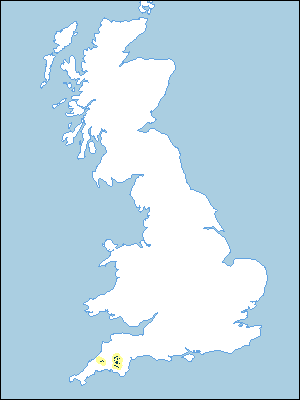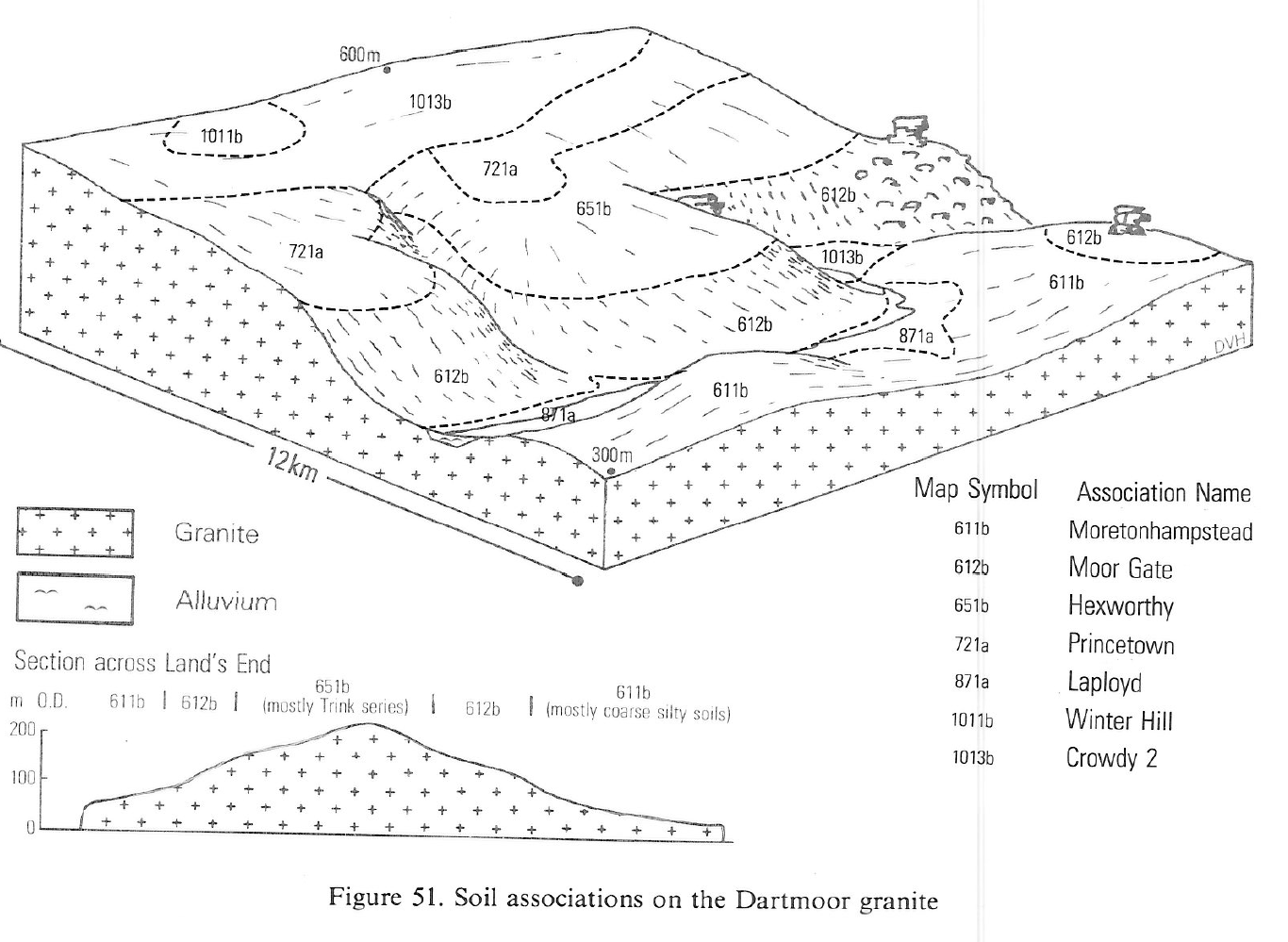
Soil Associations
0721a PRINCETOWN
Soil and site characteristics
Slowly permeable very acid gritty loamy upland soils with a wet peaty or humose surface horizon.
Geology
Granite and other acid igneous rock
Cropping and Land Use
Wet moorland habitats of moderate and poor grazing value in uplands; some improved grassland; coniferous woodland, military use and recreation.
Component soil series
| Subgroup | Series name | Percentage | WRB 2006 link |
|---|---|---|---|
| 7.21 | PRINCETOWN | 75% | Dystric Histic Stagnosols |
Covers 136 km2 in England and Wales
Soilscapes Classification
| 19 |
Slowly permeable wet very acid upland soils with a peaty surface |
0721a PRINCETOWN
Detailed Description
Princetown association is confined to the higher parts of the granite moors of South West England. On Dartmoor it occupies gentle or moderate slopes under Molinia grassland mostly above 300 m O.D. surrounding the central blanket bogs, but it also extends on to spurs and steep valley sides. On Bodmin Moor, where there is little blanket bog, it is restricted to the highest ground. The principal soils are coarse loamy cambic stagnohumic gleys of the Princetown series developed in gritty granitic rubble, locally known as growan, which is often compacted at shallow depth. A thin peaty topsoil overlies a grey, gritty often slowly permeable sandy loam horizon which in places becomes browner at depth where it merges into more permeable growan. Where the peaty topsoil thickens to form peat more than 40 cm deep, Hepste and Crowdy series occur. Typical humic gley soils of the Laployd series occupy strongly flushed sites and small hollows affected by groundwater. produced typical brown calcareous earths over part of the terrace with gleyic brown sands on its western flank.
On north-west Dartmoor, particularly around High Willhays, Princetown soils are on sloping ground littered with boulders. The steep sides of the West Okement valley have patches of Laployd series on flushed ground which also runs into the narrow valley bottoms. On central and southern Dartmoor, the association is extensive on spurs and ridges, but in drier eastern parts of the moor it is confined to high ground, as at Hameldown, Widecombe. On the broad summits of Bodmin Moor, where the land is enclosed and grazed, the former peaty surface horizon of Princetown soils has wasted to a humose topsoil. Very thin peaty or humose topsoils are also found on steep slopes marked by dry acid grassland or where peat has been stripped for fuel. Within the association there are some Heptse and Crowdy soils, either in small bogs on gently sloping hilltops, or in basins and valley floors. A few stagnopodzols of the Hexworthy and Rough Tor series are included on drier sites, particularly on the steepest slopes of minor valleys and combes cutting back into the plateaux.
Soil Water Regime
Most of the soils are permanently wet (Wetness Class VI). In high rainfall areas Princetown series with its peaty topsoils and, locally, slowly permeable subsurface horizons, are waterlogged for much of the year even though the deep subsoil is permeable. Around Lee Moor on lower ground slow natural drainage is partly due to the underlying kaolinized granite. Laployd soils are also wet, but from lateral seepage of groundwater. Winter rains run off rapidly from Princetown soils because the peaty topsoils are saturated. In summer, these soils and the thicker peats of the nearby blanket bogs store rainwater and so regulate discharge to the headwaters of many Devon rivers.
Cropping and Land Use
Annual rainfall is between 1,800 and 2,300 mm on Dartmoor though about 1,500 mm on lower ground at Lee Moor. Rainfall on the highest parts of Bodmin Moor averages about 1,800 mm annually. On Dartmoor, under the cool wet conditions, widespread Molinia grassland of moderate rough grazing value has developed. Ling is almost always present often with cross-leaved heath and whortleberry. On the drier moorland fringes, where steep slopes predominate, the organic surface is thinner and the vegetation is moist or dry atlantic heather moor of poor grazing value. Ling largely replaces purple moor-grass and is accompanied by bristle-agrostis but selective grazing maintains patches of acid bent-fescue grassland of good grazing value. The intensive stocking on Bodmin Moor suppresses the heather giving grassland of Molinia and bristle-agrostis. Acid bent-fescue grassland on the drier ground of eastern Bodmin Moor is invaded by gorse in many places.
On Dartmoor the land is mostly unenclosed common where the only management is burning and uncontrolled grazing. At Princetown, 400 ha have been enclosed and improved using prison labour to install a closely spaced system of drains. On Bodmin Moor, subsoiling has been carried out on Princetown and related soils with dense subsurface horizons to increase their permeability and improve natural drainage. Subsequent maintenance of good quality permanent pasture requires care in the timing of operations to prevent poaching, compaction of the topsoils, and damage to the sward. Though most forestry is on adjacent drier soil associations, some spreads on to Princetown soils, particularly on ridge crests. On these exposed sites, unless rooting depth is improved by deep ploughing and subsoiling, compaction and poor permeability cause windthrow. Phosphorus applications are required at planting otherwise growth is checked. Sitka spruce and Lodgepole pine are the most suitable species. Conservation interests make further extension of coniferous plantations on these soils unlikely on Dartmoor. Though not rich in wildlife the Princetown association forms an important element in the upland landscape. Some of northern Dartmoor is within the army ranges, and public access is restricted.
0721a PRINCETOWN
Distribution Map
 |
Note that the yellow shading represents a buffer to highlight the location of very small areas of the association.
Keys to component soil series
South Western Region
 |
Typical Landscapes
South Western Region
 |
All information Copyright, Cranfield University © 2024
Citation: To use information from this web resource in your work, please cite this as follows:
Cranfield University 2024. The Soils Guide. Available: www.landis.org.uk. Cranfield University, UK. Last accessed 24/04/2024
